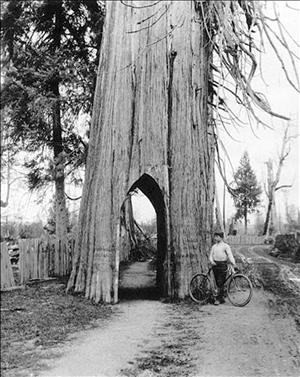An old-growth cedar tree near Snohomish gained a measure of fame after 1890 when a local logger was hired to cut a pathway through its massive trunk, allowing people to walk, bike, or ride a horse or motorcycle straight through the arch. The Bicycle Tree was a hit, a local newspaper noting that the site had become a favorite for strolling "romantic ones" (Everett Daily Herald, 1913). But on December 2, 1927, rising floodwaters from the Snohomish River undermined the tree, and with a considerable gust of wind helping out, the old giant toppled, breaking up the paved road in its epic fall.
The Famous Bicycle Tree
For centuries an extremely girthsome old-growth cedar tree – reported to have measured 13 feet 9 inches across at its base, and with a circumference of 48 feet – stood tall (in a cluster with a few cousins) at a rural spot located about a mile south of the town of Snohomish. The towering landmark was situated on the edge of Abel Johnson's (b. 1844) property right alongside of the dirt wagon road that led northward into town.
In the late-1800s the new fad of bicycle riding became popular and that dirt road became a favorite cruising route. The giant tree presumably served as a milestone of sorts, located at the junction of the Woodinville cutoff and the Cathcart and the Larimer's Corners-Lowell roads, just yards east of today's intersection of State Highway 9 and Marsh Road on Airport Way. Snohomish Bicycle Club president David Lewis Paramore (b. 1840), a Civil War vetern, is given credit for leading the effort to make the tree an unmistakable destination along a new cinder-lined bike path built next to the road. And it was Abel Johnson who kindly deeded the patch of real estate to the club.
Paramore's Civil War Pension record notes that the former Union Army soldier moved to Snohomish in 1890, and that he worked there as a druggist until retiring in 1912. But it was soon after his arrival in town that a local logger named Milligan was hired to cut a 5-feet wide by 12-feet high pathway through the massive trunk for a fee of $15.
It seemed that everybody wanted to have their picture taken at the site, and many a photographer obliged them, including notables ranging from Darius Kinsey (1869-1945) to partners Ira Webster (d. 1942) and Nelson Stevens (d. 1930). As a result there are numerous vintage photographs, and almost two dozen different postcard image variations, of the tree currently known to exist.
Fans of the tree must have been deeply concerned when an "electrical disturbance" descended on the area on the evening of August 22, 1913, and a lightning bolt "shattered the top of the giant cedar, dividing the trunk at the top of the archway ..." Though wounded, the Bicycle Tree survived for another decade-and-a-half. It remained a beloved magnet for locals and a draw for curious visitors on excursions, who now often drove to it by car. One contemporary newspaper noted that with "the advent of the automobile, cycling became less popular, and in time the Bicycle Club went out of existence" and that the "Title to the property then reverted to Mr. Johnson" (Everett Morning Tribune).
Had the generous Johnson not died in 1924 (and Paramore likewise, in 1921), they surely would have been saddened on the afternoon of December 2, 1927, when, shortly before 3 p.m., rising floodwaters from the Snohomish River, already drowning surrounding farms and the road, now undermined the tree. With a considerable gust of wind helping out, the old giant finally toppled, breaking up the paved road in its epic fall.
That day's issue of the Everett Herald included a front-page story with a headline noting that people who ventured out to have a look at the fallen icon took note of its "unusually short roots" system. On December 3, 1927, highway crews arrived and within hours what the Herald praised as a "scenic asset" to Snohomish and the Everett Morning Tribune described as "a landmark which gave the community a great deal of advertising" was transformed into little more than several cords of firewood and piles of soggy sawdust. Although the famous Snohomish Bicycle Tree had escaped the saws of Northwest loggers all those many years, a combination of lightning, wind storms, and finally a flood brought about its end.
As early as the day after its demise the Tribune was reporting that "there is now some talk of cutting an arch through the base of one of the other living trees which is even larger than the Bicycle Tree ... Thus far the movement has been but talk ..." All that chatter did, however, lead to action, and a second tunnel tree was hollowed out as a replacement. Ah, but that's a "hole" 'nother story for whole 'nother day.

